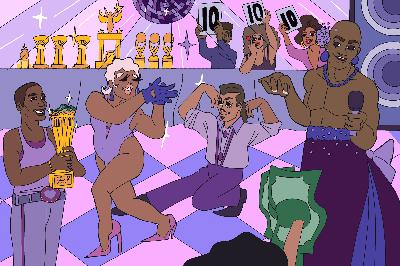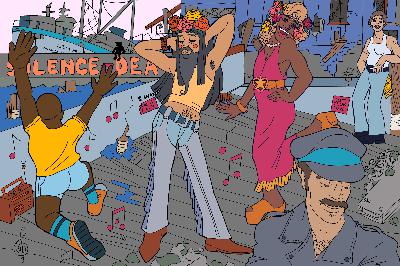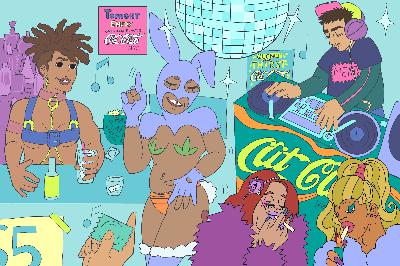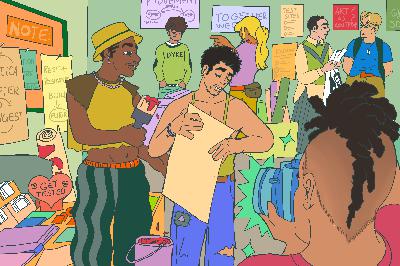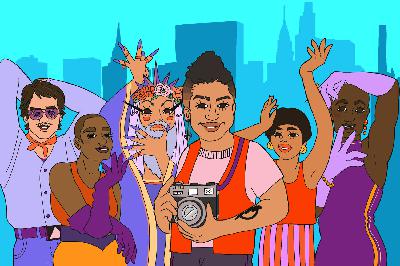Discover The MoMA Magazine Podcast
The MoMA Magazine Podcast

53 Episodes
Reverse
Two women discuss the history and artistry behind manicured nails.
In this episode of the Magazine Podcast, we speak with Dr. Tressie McMillan Cottom, a writer and sociologist, about the history of nail art and how it is connected to larger ideas around beauty, power, and freedom. We also hear from Margarita Lizcano Hernandez, a curatorial assistant at MoMA, about how nail art has changed her life.
Read the full transcript at https://www.moma.org/magazine/articles/1354
Join artist and photographer Lola Flash for a six-part podcast series exploring New York City during the AIDS epidemic of the 1980s and ‘90s.
In this final episode, Flash takes a quick trip north to Harlem, where Idris Mignott and Pamela Sneed discuss the impact of AIDS on Black and Brown folks in the city. Then, she concludes with a reflection on the state of AIDS today, calling upon the perspectives of a queer elder who lives through the crisis and a younger person who was born after its peak.
Learn more about Lola Flash, her work, and the stories shared in this project at https://www.moma.org/magazine/articles/1222
Join artist and photographer Lola Flash for a six-part podcast series exploring New York City during the AIDS epidemic of the 1980s and ‘90s.
In this penultimate episode, Flash concentrates on a single site: St. Vincent’s Hospital, which, in the 1980s, housed the first and largest AIDS ward on the East Coast. In conversation with friends Pamela Sneed, Idris Mignott, Agosto Machado, and Aldo Hernandez, Flash shares how this hospital touched their lives. She also introduces us to a new friend—someone with a different relationship to St. Vincent’s.
Learn more about Lola Flash, her work, and the stories shared in this project at https://www.moma.org/magazine/articles/1222
Join artist and photographer Lola Flash for a six-part podcast series exploring New York City during the AIDS epidemic of the 1980s and ‘90s.
For episode four, Flash wanders through memories of Christopher Street and the queer histories that took shape there. She’s joined by fellow artist Agosto Machado, as well as familiar friends Pamela Sneed and Idris Mignott, to discuss different places and spaces along the street. They share memories of the people they met on Christopher Street, and the ways love and loss shaped their lives during and after the AIDS crisis.
Learn more about Lola Flash, her work, and the stories shared in this project at https://www.moma.org/magazine/articles/1222
Join artist and photographer Lola Flash for a six-part podcast series exploring New York City during the AIDS epidemic of the 1980s and ‘90s.
Episode three looks at the ways people built community during the epidemic, and how these communities mobilized to spread knowledge, resources, and care. Flash is joined by friends Aldo Hernandez, Pamela Sneed, and Idris Mignott to discuss two organizations: the Clit Club and the Hetrick-Martin Institute.
Learn more about Lola Flash, her work, and the stories shared in this project at https://www.moma.org/magazine/articles/1222
Join artist and photographer Lola Flash for a six-part series exploring New York City during the AIDS epidemic of the 1980s and ‘90s.
Episode two reunites Flash with her longtime friend Aldo Hernandez. They discuss their involvement with ACT UP and two sites that helped shape their activism: the LGBT Center in Greenwich Village and Aldo’s apartment near Tompkins Square Park.
Learn more about Lola Flash, her work, and the stories shared in this project at https://www.moma.org/magazine/articles/1222
Join artist and photographer Lola Flash for a six-part series exploring the sites, sounds, and stories of New York City during the AIDS epidemic of the 1980s and ’90s. In this first episode, Flash introduces the series and the people you’ll meet along the way.
Learn more about Lola Flash, her work, and the stories shared in this project at https://www.moma.org/magazine/articles/1222
A climate scientist and an architect discuss how design can be a force for positive environmental change.
“I certainly remember, as a child growing up in the UK, we had a lot more snow than we do recently,” says UK-based climate scientist Ed Hawkins in this month’s episode of the Magazine podcast. Hawkins’s work, which visualizes the globe’s warming temperatures over the last 160 years, is striking in more ways than one, showing us just how quickly and dramatically the environment has been changing.
But climate change is more than escalating temperatures. It has tangible effects on how people live, and architects like Marina Tabassum have been using design as a tool to address hazardous conditions like flooding and soil erosion. For this Earth Month edition of the Magazine Podcast, we’ll also hear from Tabassum about her collaboration with Bangladesh’s landless populations and her project Khudi Bari (tiny house).
Access a transcript of the conversation at https://www.moma.org/magazine/articles/1212.
Listen to a teen-led conversation with DonChristian Jones, about building spaces for belonging and memory.
When artist DonChristian Jones started at MoMA as the inaugural Adobe Creative Resident, they created a vision for working with young people to share their stories about what art and community meant to them. In the summer of 2024, DonChristian—through their Residency at MoMA, along with the nonprofit they run, Public Assistant—and the Lower Eastside Girls Club collaborated on Frequency Gardens, a summer program and radio show.
Over the course of a month, eight teens learned how to record and edit audio, conduct live interviews, and tell their stories through art. Four of the teen participants interviewed DonChristian about their collaborative process and what it was like to hear themselves as part of the exhibition.
Read a transcript of the audio: https://www.moma.org/magazine/articles/1208
Hear from two artists and an educator about how they use improvisation to engage with art.
Improvisation informs all kinds of creative practice. But how does chance really play out in an artist’s work? And how might it inform their everyday lives?
Choreographer and dancer Mariana Valencia and artist and musician Jazmin “Jazzy” Romero test these ideas in the performance Jacklean (in rehearsal). In this episode of the Magazine podcast, they discuss how chance operates in their work, what a performance score for improvisation looks like, and share more about their collaboration. Their story of friendship and innovation is bookended by anecdotes from Sarah Dinkelacker, an educator at MoMA who uses improvisation to help people engage with art. Tune in to hear more about improvisation as a tool for life—a way to make it up as you go and move through the world with others.
Access a transcript of the conversation at https://www.moma.org/magazine/articles/1201
The future of this complex emotion is still being written, but its history can offer interesting insights on our present day.
“ Everybody fundamentally wants to be loved…to feel like they belong,” says historian Fay Bound Alberti. “But many people don’t find that, or they think about romantic love as the answer to all of their problems.” As a result, many of us end up feeling something else entirely: loneliness. Recent scientific research has described loneliness as a “modern epidemic,” an experience that can pose a threat to our health. While there is truth to these claims, they risk simplifying the complexity of this experience.
For this year’s Valentine’s Day episode of the Magazine podcast we speak to Professor Fay Bound Alberti, author of A Biography of Loneliness. She guides us through the history of this emotion—its roots in the modern era and the ways it has been depicted in the work of artists. The podcast also revisits last year’s conversation with Dr. Stephanie Cacioppo; alongside Professor Alberti, she offers strategies for reframing our perceptions of love and loneliness.
Access a transcript of the conversation at https://www.moma.org/magazine/articles/1184
Hear from artists, writers, and therapists about what happens when art and grief collide.
When was the last time you grieved? What is for a person or an animal? A place or a thing? Did you experience grief at the loss of something intangible? These questions are not meant to cause pain. Rather, they offer an opportunity to acknowledge the grief that may be hiding within us—even if it’s been several years since you experienced the loss.
Many artists have used their talents to document, understand, and share their experiences of death, dying, grief, and loss. In this Magazine podcast episode, we discuss three of these artists: Kay WalkingStick, Georg Kolbe, and Käthe Kollwitz. We’ll explore how grief entered their lives and how art helped them see it in new ways. We’ll also hear from a somatic therapist and a thanatologist (a person who studies death and grief). Together, they’ll help us make sense of this complex experience that affects our bodies, minds, and spirits, and discuss the role of art in helping us heal.
Access a transcript of the conversation here: https://www.moma.org/magazine/articles/1178
Society ridiculed the modern art she loved, so Lillie P. Bliss set out to create a museum to house it.
It might be hard to imagine, but there was a time when the work of modern artists like Vincent van Gogh, Henri Matisse, and Paul Cézanne was ridiculed by the public. Despite all the criticism, three women founded a museum dedicated to art that was new. In this edition of the Magazine podcast, we explore the life and work of Lillie P. Bliss, one of MoMA’s three founders and a passionate advocate for modern art. Bliss is also the subject of MoMA’s exhibition Lillie P. Bliss and the Birth of the Modern. Described by her niece as “the most typical Victorian daughter,” the dutiful Bliss nonetheless defied not only society but her parents by going on to build an art collection that became the cornerstone of The Museum of Modern Art.
Access a transcript of the conversation here: https://www.moma.org/magazine/articles/1169
A hundred years later, a Surrealist artwork continues to inspire curiosity in all who encounter it.
“It is an object that—once you’ve seen it, it’s there in your imagination forever,” says former MoMA senior curator Anne Umland about Meret Oppenheim’s Surrealist Object. Objects conservator Caitlin Gozo Richeson had a similar reaction on seeing the fur-lined teacup, saucer, and spoon for the first time as a MoMA intern. “I remember seeing it in the galleries and just being floored,” she recalls. “For me, it’s always been one of those objects that is just so burned into my memory and my senses.”
Oppenheim’s Object is one of the most celebrated works in MoMA’s collection—and for good reason. It’s an artwork full of wonder and humor, often leaving us with more questions than answers. For this edition of the Magazine podcast, we plumb the mysteries of an artwork that has come to embody Surrealism, an artistic and literary movement celebrating its 100th anniversary this year.
Access a transcript of the conversation here: https://www.moma.org/magazine/articles/1133
Jazz in the Garden, Episode Three: “Return to the Garden”
An overwhelmingly popular series of jazz concerts in MoMA’s Sculpture Garden in 1985 proved…a little too popular, and it would be nearly a decade before live jazz was once again a regular occurrence at the Museum. In our third and final episode, hear about a new generation of musicians who revived the legacy of jazz at the Museum in the 1990s, and brought it into the 21st century.
Writer/producers: Naeem Douglas, Alex Halberstadt, Jason Persse
Host: Naeem Douglas
Additional readings: Karen Chilton
Engineer, mixer, original music: Zubin Hensler
Special thanks: Prudence Peiffer, Arlette Hernandez, Ellen Levitt, Kelsey Head, Dore Murphy, Allison Knoll, Tina James, Michelle Harvey, Marc-Auguste Desert II, Omer Leibovitz, Peter Oleksik
Music:
“Namesake.” Written and performed by Milt Jackson. Courtesy of Universal Music Group. By arrangement with Reecie Music; “Soloscope, Part 1.” Written and performed by Sonny Rollins. Courtesy of Concord Records. By arrangement with Kobalt obo Son Rol Music Company; “Strauss Waltz Medley.” Written by Johann Strauss II. Performed by the United States Air Force Band. Public domain recording; “The Thrill Is Gone.” Written by Ray Henderson and Lew Brown. Performed by Claudia Acuña. Used by permission. By arrangement with Warner Chappell Music; “Mambo Jazz.” Written (as “Titorama”) by Chris Washburne. Performed by Chris Washburne and the Syotos Band. Used by permission. Courtesy Wash and Burne Music; “Moon Bird.” Written by Myra Melford. Performed by Myra Melford’s The Tent. Used by permission. Courtesy Myra Melford; “Malinke’s Dance.” Written by Marty Ehrlich. Performed by the Marty Ehrlich Sextet. Used by permission. Courtesy Marty Ehrlich
Hear from current and former teens about their experiences of growing up queer.
When was the last time you thought about your teenage self?
For a lot of us, our teenage years were an uncomfortable time. Sure, there were some good moments, but there were also a lot of confusing thoughts and big emotions that we couldn't figure out. For Pride 2024, we invite you to enter the world of Open Art Space (OAS), MoMA’s weekly drop-in program for LGBTQ+ high school students and their allies. You’ll hear from different community members about the ways they discovered and embraced their identity as queer people. They discuss what it was like growing up queer, the role of art in their lives, and the places and spaces that played a vital role in making them feel safe.
Jazz in the Garden, Episode Two: “One Magic Summer”
After a golden age of big names and big crowds throughout the 1960s, by the mid 1970s live jazz at MoMA had become something of an afterthought. But a magical summer of performances in 1985—including landmark concerts by the Art Ensemble of Chicago, “Butch” Morris, and the “saxophone colossus” himself, Sonny Rollins—put the music back at center stage. Join us for our second episode, and hear the story from Rollins and others who were there.
Writer/producers: Naeem Douglas, Alex Halberstadt, Jason Persse
Host: Naeem Douglas
Additional readings: Karen Chilton
Engineer, mixer, original music: Zubin Hensler
Special thanks: Prudence Peiffer, Arlette Hernandez, Ellen Levitt, Kelsey Head, Dore Murphy, Allison Knoll, Tina James, Michelle Harvey, Marc-Auguste Desert II, Omer Leibovitz, Peter Oleksik
Music:
“Now’s the Time.” Written by Charlie Parker. Performed by Clark Terry. Courtesy of The Orchard. By arrangement with Universal Music Publishing and Sony Music Publishing; “Uncle.” Written by Roscoe Mitchell. Performed by the Art Ensemble of Chicago. Courtesy of Universal Music Group. By arrangement with Art Ensemble of Chicago Publishing; “Soloscope, Part 1.” Written and performed by Sonny Rollins. Courtesy of Concord Records. By arrangement with Kobalt obo Son Rol Music Company; “Namesake.” Written and performed by Milt Jackson. Courtesy of Universal Music Group. By arrangement with Reecie Music; “On Green Dolphin Street.” Written by Kaper Bronislaw, Ned Washington. Performed by Sonny Rollins. Courtesy of Universal Music Group. By arrangement with Reservoir Media, BRTS, and BMG
Jazz in the Garden, Episode One: “In the Beginning”
Our story begins on June 16, 1960, when George Wein and the Storyville Sextet played the first jazz concert in MoMA’s Sculpture Garden—and launched more than a decade of legendary performances and recordings from some of the leading lights of jazz, including Dizzy Gillespie, Thelonious Monk, Duke Ellington, and Sonny Rollins. In this episode, you’ll hear about the first era of jazz at MoMA from some of the musicians who were there.
Writer/producers: Naeem Douglas, Alex Halberstadt, Jason Persse
Host: Naeem Douglas
Additional readings: Karen Chilton
Engineer, mixer, original music: Zubin Hensler
Special thanks: Prudence Peiffer, Arlette Hernandez, Ellen Levitt, Kelsey Head, Dore Murphy, Allison Knoll, Tina James, Michelle Harvey, Marc-Auguste Desert II, Omer Leibovitz, Peter Oleksik
Music:
“That’s a Plenty” (Live) (2014 remaster). Written by Lew Pollack. Performed by George Wein and the Storyville Sextet. Courtesy of Bethlehem Records. By arrangement with BMG Rights Management; “Soloscope.” Written and perfrormed by Sonny Rollins. Courtesy of Concord Records. By arrangement with Kobalt obo Son Rol Music Company; “Namesake.” Written and performed by Milt Jackson. Courtesy of Universal Music Group. Bt arrangement with Reecie Music; “September in the Rain.” Written by Al Dubin, Harry Warren. Performed by George Wein and the Storyville Sextet. Courtesy of BMG. By arrangement with WC Music Corp. (ASCAP); “Undecided.” Written by Charles Shavers. Performed by George Wein and the Storyville Sextet. Courtesy of BMG. By arrangement with Universal Music Publishing; “Novamo.” Written and performed by Milt Jackson. Courtesy of Universal Music Group. By arrangement with Hall Leonard; “Take the A Train.” Written by Billy Strayhorn. Performed by Clark Terry. Courtesy of The Orchard. By arrangement with Reservoir Media and WISE; “Take Three Parts Jazz.” Written by Teddy Charles. Performed by the Teddy Charles New Directions Quartet. Courtesy of 43 North Broadway LLC. By arrangement with Raybird Music; “A Night in Tunisia.” Written by John Gillespie, Frank Paparelli. Performed by the Dizzy Gillespie Quintet. Courtesy of Universal Music Group; “On Green Dolphin Street.” Written by Kaper Bronislaw, Ned Washington. Performed by Sonny Rollins. Courtesy of Universal Music Group. By arrangement with Reservoir Media, BRTS, and BMG; “The Quota.” Written by Jimmy Heath. Performed by Milt Jackson. Courtesy of Universal Music Group. By arrangement with Hall Leonard; “Now’s The Time.” Written by Charlie Parker. Performed by Clark Terry. Courtesy of The Orchard. By arrangement with Universal Music Publishing and Sony Music Publishing
Hear how this popular crop is helping craft a more sustainable future in Mexico.
What do corn, craft, and Mexico have in common? The answer to this question comes in the form of Totomoxtle, a project and materials created by designer Fernando Laposse in collaboration with the village of Tonohuixtla. On view through July 7 in the exhibition Life Cycles: The Materials of Contemporary Design, Totomoxtle is an example of how good design can do more than please the eye—it can offer new pathways to preserving cultures, supporting local communities, and bringing balance to an ecosystem that has been exploited for far too long.
For this Earth Month edition of the Magazine podcast, we sat down with Laposse to discuss the origins of his Totomoxtle project and how corn is helping build a more sustainable future for people and planet.
Access a transcript of the conversation here: https://www.moma.org/magazine/articles/1062
Is art the secret to everlasting love?
It’s no secret that some of the most powerful art has been inspired by love, that singular, indescribable feeling that, as it turns out, we are all capable of experiencing. “We all have the 12 brain areas that are critical for love,” says Dr. Stephanie Cacioppo, a leading figure in the neuroscience of social connections. It doesn’t matter if that love we feel is for our friends, our community, or our romantic partners, the only thing that changes between these relationships is the intensity we feel and see in the brain. What’s more, when we embrace that love, amazing things can happen and our brains become stronger.
In this Valentine’s Day episode of the Magazine Podcast, we’re exploring the science of love and how art can help foster it. We’ll hear from Dr. Cacioppo about her research, and from a couple who met at MoMA more than 50 years ago. Together, they’ll teach us that we don’t need to look far for love—sometimes we’ll find it where we least expect.
Access a transcript of the conversation here: moma.org/magazine/articles/1027


